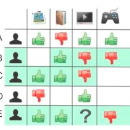Recently, graph collaborative filtering methods have been proposed as an effective recommendation approach, which can capture users' preference over items by modeling the user-item interaction graphs. In order to reduce the influence of data sparsity, contrastive learning is adopted in graph collaborative filtering for enhancing the performance. However, these methods typically construct the contrastive pairs by random sampling, which neglect the neighboring relations among users (or items) and fail to fully exploit the potential of contrastive learning for recommendation. To tackle the above issue, we propose a novel contrastive learning approach, named Neighborhood-enriched Contrastive Learning, named NCL, which explicitly incorporates the potential neighbors into contrastive pairs. Specifically, we introduce the neighbors of a user (or an item) from graph structure and semantic space respectively. For the structural neighbors on the interaction graph, we develop a novel structure-contrastive objective that regards users (or items) and their structural neighbors as positive contrastive pairs. In implementation, the representations of users (or items) and neighbors correspond to the outputs of different GNN layers. Furthermore, to excavate the potential neighbor relation in semantic space, we assume that users with similar representations are within the semantic neighborhood, and incorporate these semantic neighbors into the prototype-contrastive objective. The proposed NCL can be optimized with EM algorithm and generalized to apply to graph collaborative filtering methods. Extensive experiments on five public datasets demonstrate the effectiveness of the proposed NCL, notably with 26% and 17% performance gain over a competitive graph collaborative filtering base model on the Yelp and Amazon-book datasets respectively. Our code is available at: https://github.com/RUCAIBox/NCL.
翻译:最近,有人提议采用图表合作过滤方法,作为一种有效的建议方法,通过模拟用户项目互动图表,可以捕捉用户对项目的偏好。为了减少数据宽度的影响,在图形合作过滤中采用了对比式学习,以提高性能。然而,这些方法通常通过随机抽样构建对比配对,忽视用户(或项目)之间的相邻关系,未能充分利用对比学习的潜力来提出建议。为了解决上述问题,我们提议了一种新型对比式学习方法,名为“邻里博尔格-富盛盛盛的对比性学习”,名为NCL,明确将潜在邻居纳入对比式配对。具体地说,我们从图表结构和语义空间空间空间空间空间空间中分别引入一个用户(或项目)的邻居。对于互动图上的结构性邻居,我们提出了一个新的结构调控点,将用户(或项目)及其结构相近邻作为正式17式模型。在实施中,用户(或项目)和邻居对GNNNP层产出的表达方式。此外,我们用直径可见的直径网络数据库和直径直径直径直径直径直路路路路路路路路路路路路路路路路路路路路路路路路路路路,将显示。我们内部的图像中,将这些直径直路路路路路路路路路路路路路路路路路路路路路路路路路路路路路路路路路路路路路路路路路路路路路路路路路路路路路路路路路路路路路路路路路路路路。




